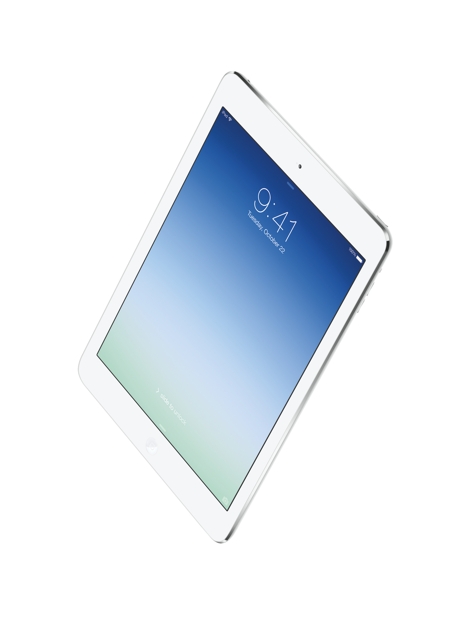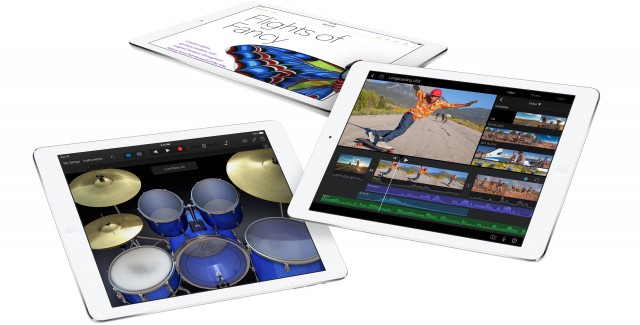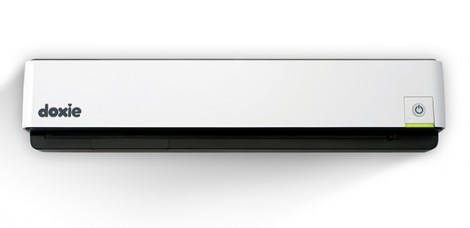Written by Dave Mark
Three reviewers, three positive takes.
Walt Mossberg reviewed the iPad Air for the Wall Street Journal:
In my tests, the iPad Air far exceeded Apple’s claim of 10 hours of battery life. For over 12 hours, it played high-definition videos, nonstop, with the screen at 75% brightness, with Wi-Fi on and emails pouring in. That’s the best battery life I’ve ever recorded for any tablet.
I’ve been testing the iPad Air for about a week and found it a pleasure to use. This new iPad isn’t a radical rethinking of what a tablet can be, but it’s a major improvement on a successful product. It is the best tablet I’ve ever reviewed.
That isn’t just because of its slimmer, lighter design, but because Apple boasts 475,000 apps optimized for tablet use—far more than any other tablet platform. (The iPad also can run all of the million or so apps available for the iPhone.) By contrast, the vast majority of apps available for rival Android tablets are just stretched versions of phone apps.
Damon Darlin reviewed the iPad Air for the New York Times:
It easily runs for 10 hours on a charge, just as Apple promises — despite the battery’s smaller size and the increased demands put on it. In my test of pretty heavy use, it downloaded and played three hourlong episodes of “Game of Thrones” and a few hours of music. I scrolled through Twitter and Flipboard, played games and perused the web. That’s almost a typical day for me and my iPad. It will get you through a normal day and then some with no worries.
The iPad Air also sports two antennas to pull in Wi-Fi signals faster than the old one did. Called MIMO for multiple-input and multiple-output, these antennas make a noticeable difference when your fast Wi-Fi signal is weakest, like in a back bedroom or the basement. (You’ll have to have a recent MIMO compatible router to see the magic, though.)
Finally, David Pogue reviewed the iPad Air on his Tumblr, as he makes the transition from the New York Times to his new digs at Yahoo. Pogue points out much of the same things, but also made this point:
This time around, there’s no gotta-have new feature—nothing on the level of the Retina screen, Siri voice recognition, or even a fingerprint reader (like the one on the iPhone 5s).
That big public yawn must drive Apple’s engineers crazy. The thing is, making the iPad smaller, lighter, and faster without sacrificing battery life or beauty is a tremendous achievement.
Of course, if you haven’t already, be sure to read Jim Dalrymple’s personal take on the iPad Air, too.
October 29, 2013
From the minute I picked up the iPad Air at Apple’s event in San Francisco last week, I knew it was going to be different. Apple set expectations very high by simply using the “Air” moniker for the new iPad, giving users thoughts of a lightweight, powerful, professional device, similar to how they think of the MacBook Air.
The good news is the iPad Air lives up to all of those expectations and more.
When I first picked up the iPad Air, I noticed how light it was. I mean really light. In reality, Apple shaved about half a pound of weight off the new iPad compared to the previous generations. That may not seem like much, but when the old iPad only weighed approximately 1.5 pounds, knocking off half a pound is significant.
I must admit, at first I was wondering if the new iPads Apple had on display at the event were prototypes—empty fakes that didn’t actually work, but showed what the form-factor would be like when they were released. I’m pleased to say that they were the real thing.

It’s very hard to describe how good the iPad Air feels in your hand without actually picking one up. It’s kind of like the first time you saw a Retina display for the first time—shock.
The other thing you will quickly notice is that while the screen size of the iPad Air is the same as the previous generation, the Air is actually a smaller device. The height is the same, but the width is considerably narrower.
Apple made the distance between the edge of the screen and edge of the iPad smaller on both sides, accounting for the smaller size. The iPad Air now resembles the iPad mini in that respect.
This smaller size is great. If you have decent sized hands you can type with two thumbs on the iPad in portrait, something I wasn’t really able to do with the last generation iPad without a lot of stretching. Clearly a full-size iPad is not something you will be thumb typing with all the time1, but it does give you an idea of how much smaller the iPad Air is.
The iPad Air also comes with Apple’s A7 chip, the fastest chip the company has manufactured to date. Power has never been something I worried about on an iPad and I certainly won’t be worried with this new version.
The A7 is a 64-bit chip that is packed with power. There aren’t any apps or any situation that I have tried or can think of that would slow down this iPad. In fact, the A7 chip has twice the processing power and graphics performance as the A6X chip found in the iPad 4. That’s an astounding amount of power increase for a single generation.
The Air is also equipped with the M7 chip, a new coprocessor first introduced on the iPhone 5s. The M7 takes data from the accelerometer, gyroscope, and compass and can deliver that information to apps without accessing the A7. This ultimately means power savings for the user because the more power hungry A7 doesn’t have to work at gathering that information.
Speaking of power—let’s talk about the battery. I don’t use my iPad all day, every day, but I do use it on occasion throughout the day. For instance, if I have an appointment, I’ll take the iPad with me and do some writing. I did that today.
I sat for a few hours today, utilizing LTE for Internet, and writing in Byword. I was doing simple things really—nothing that was taxing for such a powerful device, but still important work for me.
I used it a few more times during the day for research, email, surfing the Web and other such tasks. I wrote and edited part of this review on it. As I type this, there is 84% of my battery remaining. Not bad for having a device at my disposal all day long, ready to do anything I need.
I always opt for the cellular model iPad because I think it’s the smart choice. We can have Internet almost anywhere we go these days and I want that option. We can get very cheap data packages, so why not do that.
My wife never gets the cellular model and it came back to bite her on a couple of occasions—the last time was just before I left for the Apple event.
We were going to see a new puppy at the dog rescue she volunteers for. She had the address on her iPad mini, but forgot to bring up the email before we left the house. Of course, when she did try to search for it, we were on the road without a connection. We had to stop at a coffee shop, get a Wi-Fi connection and find the address. It was a pain, but we had little choice2.
The last thing that stood out to me with the iPad Air are the apps. I usually don’t talk about apps when I look at an iPhone or iPad, but this time, they deserve a mention.
It would have been great for users if Apple released iLife and iWork free for its users. Instead, the company updated iPhoto, iMovie, GarageBand, Pages, Numbers, and Keynote and then made them free.

This is a huge win for users. Apple is giving away the OS and now it is giving away all of the apps people need to do work and have fun. Everything you need is free. It’s not just that the apps are free that’s impressive—it’s that they are really good apps.
I spoke at a conference in San Francisco last week after the iPad event, so I had a chance to use the apps in real-world circumstances. I worked on my Keynote presentation on my iPad, made notes in Pages on my iPhone and worked on The Loop Magazine payments in Numbers, all while sitting in Union Square enjoying a coffee. When I got back to the hotel, all of my work was available on iCloud when I turned on my Mac.
That’s powerful and efficient. I got things done. That’s what software and hardware are supposed to do for you. That’s what the iPad Air and iWork did for me.
Written by Dave Mark
Currently, all wireless broadcasting uses two frequencies, one for transmit, and one for receive.
The underlying technology, known as full-duplex radio, tackles a problem known as “self-interference.” As radios send and receive signals, the ones they send are billions of times stronger than the ones they receive. Any attempt to receive data on any given frequency is thwarted by the fact that the radio’s receiver is also picking up its own outgoing signal.
For this reason, most radios—including the ones in your smartphone, the base stations serving them, and Wi-Fi routers—send information out on one frequency and receive on another, or use the same frequency but rapidly toggle back and forth. Because of this inefficiency, radios use more wireless spectrum than is necessary.
The technique behind the startup is similar to that used in sound canceling headphones.
To solve this, Kumu built an extremely fast circuit that can predict, moment by moment, how much interference a radio’s transmitter is about to create, and then generates a compensatory signal to cancel it out. The circuit generates a new signal with each packet of data sent, making it possible to work even in mobile devices, where the process of canceling signals is more complex because the objects they bounce off are constantly changing.
Not sure if this technology is a game changer all by itself. This is useful when there’s a lot of back and forth, but not so much when receiving or sending large chunks of data. But I suspect it represents the overall direction of WiFi and cellular evolution.
October 28, 2013
Apple on Monday reported its fourth quarter results, posting revenue of $37.5 billion and a profit of $7.5 billion. This compares to revenue of $36 billion and net profit of $8.2 billion in the year-ago quarter.
Apple said it sold 33.8 million iPhones, a record for the September quarter, compared to 26.9 million in the year-ago quarter. The company also sold 14.1 million iPads during the quarter, compared to 14 million in the year-ago quarter, and it sold 4.6 million Macs, compared to 4.9 million in the year-ago quarter.
The company said international sales accounted for 60 percent of the quarter’s revenue.
Apple’s Board of Directors declared a cash dividend of $3.05 per share of the company’s common stock. The dividend is payable on November 14, 2013, to shareholders of record as of the close of business on November 11, 2013.
Written by Jim Dalrymple
I’d like to thank IK Multimedia for sponsoring The Loop’s RSS feed this week with the iRig BlueBoard.
iRig BlueBoard is the first wireless MIDI pedalboard for iOS and Mac that allows you to control your music apps and more from the floor. Now control parameters of your MIDI-compatible apps like AmpliTube wirelessly from the floor. Switch between presets, change patches, turn effects on and off and control effects like volume wah pedals all from the stage floor without worrying about tripping over wires. Setup is as simple as turning the iRig BlueBoard on and telling it what you want to control. iRig BlueBoard features four backlit soft-touch pads housed in a sturdy, stage-worthy chassis, two TRS expansion jacks for connecting additional MIDI controllers like expression pedals, and is powered by four standard AAA batteries.
IK Multimedia’s iRig BlueBoard allows guitarists, vocalists and keyboard players wireless control of Core-MIDI-compatible music-making apps running on an iPhone (4s or later), iPad 4, iPod touch (5th gen) or Mac (models from June 2012). The pedalboard has four backlit pads up top, which can each be assigned controls to switch between presets and banks, tweak parameters or change patches on the fly. Expression, volume or wah pedals can also be connected to the two 0.25-in jacks on the side of the device for control of onscreen dials and knobs.





